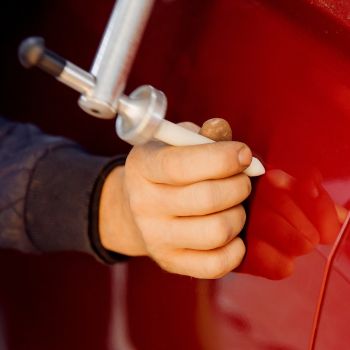 Paintless Dent Repair (PDR) is a modern and efficient way to fix minor dents on your car without damaging the original paint. This technique involves carefully massaging the dent from the inside out using specialized tools, restoring the metal’s shape while preserving its factory finish.
Paintless Dent Repair (PDR) is a modern and efficient way to fix minor dents on your car without damaging the original paint. This technique involves carefully massaging the dent from the inside out using specialized tools, restoring the metal’s shape while preserving its factory finish.
This method not only improves your vehicle’s appearance but also helps maintain its value by avoiding the need for repainting or filler use. It’s faster, more cost-effective, and often results in a more durable fix compared to traditional methods. PDR is suitable for both new and older vehicles, though it doesn’t work for every type of damage. Let’s explore what it can and cannot do.
What Is Paintless Dent Repair?
Paintless Dent Repair is a non-invasive technique that allows technicians to remove small dents and dings without sanding, painting, or filling. Instead, they use a combination of tools and careful manipulation to push the metal back into place from behind the panel. This keeps the original paint intact and ensures a seamless finish. The benefits include:
- Quick and efficient repairs
- Lower costs compared to traditional methods
- Preservation of the original factory paint
- No need for fillers or repaints
- Long-lasting and natural-looking results
What Can Paintless Dent Repair Fix?
PDR works best for specific types of damage. Here are some common situations where it’s effective:
- Small to medium-sized dents
- Dents caused by low-force impacts like hail or door dings
- Vehicles manufactured after 1990 (as newer cars have more flexible metal)
- Paint that is intact and not chipped or cracked
- Single, isolated dents that haven’t been previously repaired
- Dents located away from panel edges
- Restoration of antique cars without repainting
- Dents that only affect metal, not plastic parts
- Multiple small dents, such as those from a hailstorm
A qualified technician will assess the depth, location, and condition of the dent to determine if PDR is the right solution for your car.
When PDR Is Not Recommended
While PDR is great for many issues, it’s not always the best option. Avoid PDR if:
- The damage involves dented or cracked plastic (like a bumper)
- The dent is deep or has stretched the metal significantly
- Part of the paint has been removed
- The dent was caused by hitting an animal or large object
- The dent is near the edge of a panel or in an inaccessible area
If you're looking for a fast, affordable, and high-quality way to restore your car's appearance, consider Paintless Dent Repair. Contact DaSilva’s Auto Body today to schedule a free consultation and see if your car is a good candidate for this innovative service.
One of the main advantages of greenboards is their durability. The steel sheet base material is strong and long-lasting, while the green coating is resistant to scratches, stains, and other types of damage. This makes greenboards a good choice for high-traffic classrooms where the writing surface may be subject to frequent use.
Greenboards are also easy to clean. The non-porous surface can be wiped clean with a damp cloth or eraser, making it quick and easy to maintain. Additionally, the green color of the board provides a high contrast for writing with chalk or markers, making it easy to read from a distance.
Another advantage of greenboards is that they are less reflective than whiteboards, which can reduce glare and eye strain for students and teachers. The matte finish of the green coating also provides a more natural writing surface, which some people may prefer over the smooth, slippery surface of a whiteboard.
Overall, greenboards are a popular choice for schools due to their durability, ease of cleaning, and high contrast writing surface. While digital whiteboards and other high-tech tools have become more common in some schools, greenboards remain a reliable and effective teaching aid in many classrooms.
Greenboard Steel Coil,greenboard steel board,raw material for greenboard,ppgi greenboard for writing
Wuxi Shengshu Metal Co., Ltd. , https://www.wuxissmetal.com